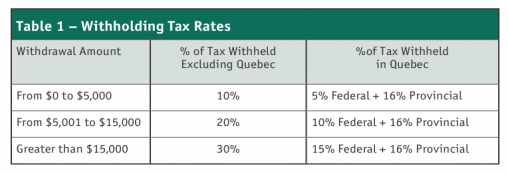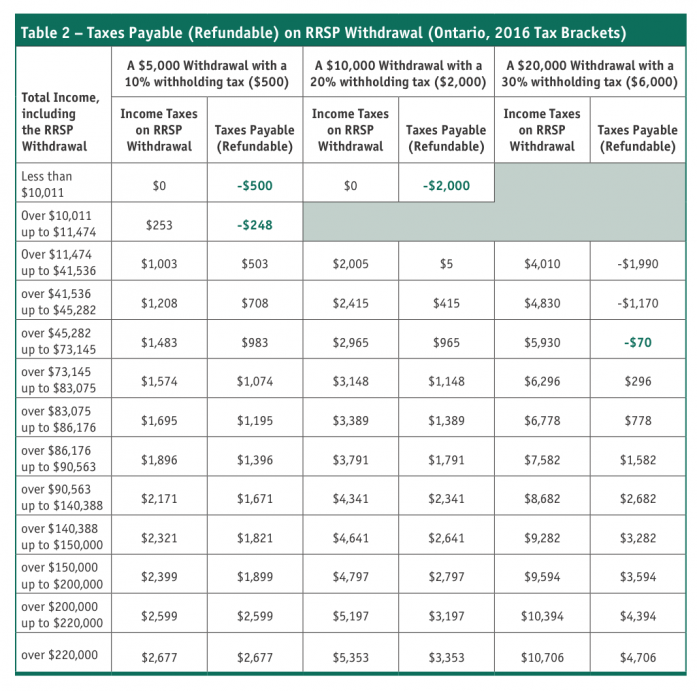Understanding The RRSP Withdrawal Withholding Tax

The purpose of this article is to explore the nature of the withholding tax on lump sum withdrawals from an RRSP.
Withholding Tax
When funds are withdrawn from an RRSP, tax is withheld by the financial institution. The withholding tax rate levied depends on the amount withdrawn. Table 1 below presents the withholding tax rates.

A withholding tax rate of 25% is levied for non-residents although there may be some relief through an applicable tax treaty.
It is important to note that the withholding tax rates are only estimates and do not represent the actual tax that is to be paid on the RRSP withdrawal.
Actual Taxes Payable On RRSP Withdrawal
It is important to understand that the withholding tax levied on the RRSP withdrawal is not the actual tax that will be paid. Much like income tax withheld by an employer on employment income, the withholding tax on an RRSP withdrawal is only an estimate. The true taxes payable on an RRSP withdrawal is calculated when an individual files their tax return.
Table 2 presents the taxes payable, after accounting for the withholding tax levied, for an RRSP withdrawal at various individual income levels.

Some Implications
Assume that an individual with no income in a year decides to withdraw $20,000 from their RRSP. The financial institution would be obligated to withhold $6,000, leaving the individual with $14,000. However, the taxes payable on the RRSP withdrawal will be approximately $4,010. The individual will be required to wait until they file a tax return and receive a refund before they will obtain the additional $1,990 ($4,010 less $4,010).
If an individual is in dire need of the RRSP withdrawal funds, they can structure the withdrawal in four $5,000 withdrawals in order to pay only $2,000 on the withdrawals ($5,000 x 10% x 4). Note that if the withdrawals are too close together, many financial institutions will group the withdrawals together and apply the withholding tax on the aggregate amount. You should consult with your financial institution to determine the specifics of your situation. In addition, making withdrawals from RRSPs with different institutions can alleviate this issue.
Other Considerations
It is important to also note that an RRSP withdrawal will be considered taxable income and can therefore lead to the potential for a clawback of the Guarantied Income Supplement, Age Credit or Old Age Security. Any such clawbacks have not been factored into the calculations of Table 2.
A Note On RRIFs
There is no withholding tax when the minimum amount is withdrawn from a RRIF. However, the withholding tax will be levied on withdrawals that are in excess of the minimum amounts.
More details can be found on withholding tax on payments from a RRIF on CRA’s website at the following link:
http://www.cra-arc.gc.ca/tx/rgstrd/rrsprrif-reerferr/fq-eng.html#wthhldng
Camillo Lento, PhD, CPA, CA, CFE, Faculty of Business Administration, Lakehead University, Thunder Bay, ON (807) 343-8387, clento@lakeheadu.ca.

